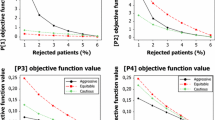Abstract
We consider the patient-to-bed assignment problem that arises in hospitals. Both emergency patients who require hospital admission and elective patients who have had surgery need to be found a bed in the most appropriate ward. The patient-to-bed assignment problem arises when a bed request is made, but a bed in the most appropriate ward is unavailable. In this case, the next-best decision out of a many alternatives has to be made, according to some suitable decision making algorithm. We construct a Markov chain to model this problem in which we consider the effect on the length of stay of a patient whose treatment and recovery consists of several stages, and can be affected by stays in or transfers to less suitable wards. We formulate a dynamic program recursion to optimise an objective function and calculate the optimal decision variables, and discuss simulation techniques that are useful when the size of the problem is too large. We illustrate the theory with some numerical examples.




Similar content being viewed by others
References
Abera, A. K., O’Reilly, M. M., Holland, B. R., Fackrell, M., & Heydar, M. (2019). Decision support model for the patient admission scheduling problem with random arrivals and departures. In Proceedings of the 10th international conference on matrix-analytic methods in Stochastic models, 13–15 February 2019, Hobart, Australia (pp. 10–14).
Abera, A. K., O’Reilly, M. M., Holland, B. R., Fackrell, M., & Heydar, M. (2020). On the decision support model for the patient admission scheduling problem with random arrivals and departures: A solution approach. Stochastic Models, 30(2), 312–336.
Ceschia, S., & Schaerf, A. (2011). Local search and lower bounds for the patient admission scheduling problem. Computers and Operations Research, 38(10), 1452–1463.
Ceschia, S., & Schaerf, A. (2012). Modeling and solving the dynamic patient admission scheduling problem under uncertainty. Artificial Intelligence in Medicine, 56(3), 199–205.
Ceschia, S., & Schaerf, A. (2016). Dynamic patient admission scheduling with operating room constraints, flexible horizons, and patient delays. Journal of Scheduling, 19(4), 377–389.
Cumani, A. (1982). On the canonical representation of homogeneous Markov processes modelling failure—time distributions. Microelectronics Reliability, 22(3), 583–602.
Fackrell, M. (2009). Modelling healthcare systems with phase-type distributions. Health Care Management Science, 12(1), 11–26.
Hulshof, P. J. H., Mes, M. R. K., Boucherie, R. J., & Hans, E. W. (2016). Patient admission planning using approximate dynamic programming. Flexible Services and Manufacturing Journal, 28(1–2), 30–61.
Latouche, G., & Ramaswami, V. (1999). Introduction to Matrix Analytic Methods in Stochastic Modelling. Princeton, NJ: ASA SIAM.
Marshall, A. H., & McClean, S. I. (2003). Conditional phase-type distributions for modelling patient length of stay in hospital. International Transactions in Operational Research, 10(6), 565–576.
Mes, M. R., & Rivera, A. P. (2017). Approximate dynamic programming by practical examples. In R. Boucherie & N. van Dijk (Eds.), Markov decision processes in practice. International series in operations research and management science (Vol. 248, pp. 63–101). Cham: Springer.
Powell, W. (2009). What you should know about approximate dynamic programming. Naval Research Logistics, 56(3), 239–249.
Powell, W. (2011). Approximate dynamic programming: Solving the curses of dimensionality (2nd ed.). Boca Raton: Wiley.
Powell, W. B. (2016). Perspectives of approximate dynamic programming. Annals of Operations Research, 241(1–2), 319–356.
Vancroonenburg, W., De Causmaecker, P., & Vanden Berghe, G. (2012). Patient-to-room assignment planning in a dynamic context. In Proceedings of the 9th international conference on the practice and theory of automated timetabling (PATAT-2012) (pp. 193–208).
Author information
Authors and Affiliations
Corresponding author
Additional information
Publisher's Note
Springer Nature remains neutral with regard to jurisdictional claims in published maps and institutional affiliations.
This research was supported by funding through the Australian Research Council Linkage Project LP140100152.
Rights and permissions
About this article
Cite this article
Heydar, M., O’Reilly, M.M., Trainer, E. et al. A stochastic model for the patient-bed assignment problem with random arrivals and departures. Ann Oper Res 315, 813–845 (2022). https://doi.org/10.1007/s10479-021-03982-9
Accepted:
Published:
Issue Date:
DOI: https://doi.org/10.1007/s10479-021-03982-9




